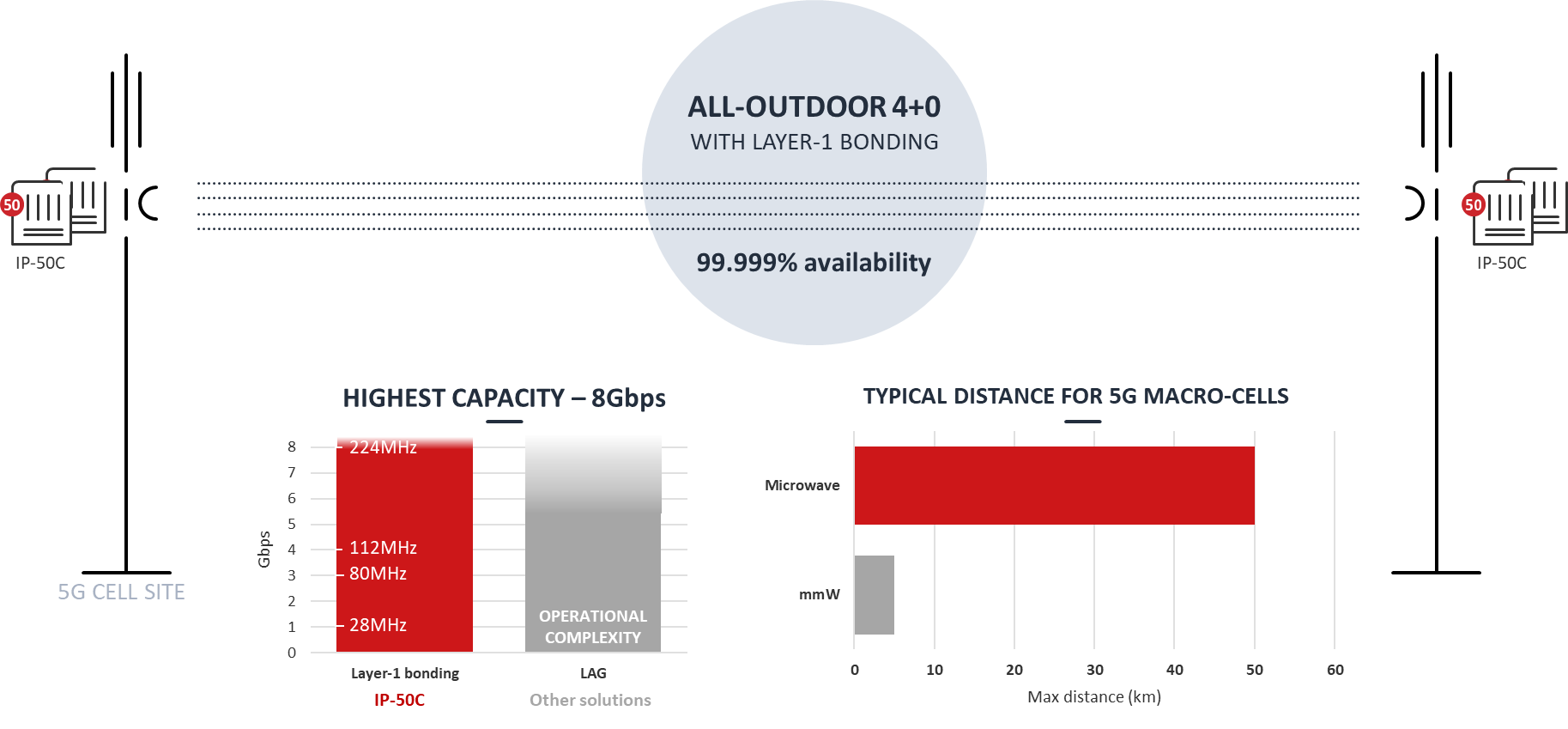|
|
5G means more capacity, much more capacity, in any part of the network. This understanding is well established by network planners as well as solution vendors.
When it comes to the hauling network domain (backhaul, midhaul and fronthaul), network planners (and vendors) have come to another realization; in order to keep the needed flexibility in deploying new sites and upgrading existing sites when evolving the network and services to 5G, those hauling requirements must be answered (also) by a wireless solution. This enables operators to eliminate the dependency on fiber availability, feasibility, timing and cost when selecting a location for a new base station.
So, we need a high-capacity wireless backhaul, midhaul and fronthaul solution for the 5G network. But how high? What capacity?
The following table gives us a rough estimate for such capacity requirements, per the RAN band and channel spacing used:

Capacity requirements span from 2Gbps to over 30Gbps. Though given the practice of fronthaul compression and the tendency to use midhaul rather than fronthaul in millimeter wave-based RAN, it is safe to assume that the current solution with 20Gbps capacity is more than adequate to cover all reasonable scenarios.
But if our multi-Gbps wireless solution is limited to the millimeter wave (mmW) domain (currently E-Band, and in the future W-Band and D-Band), how can we resolve the capacity challenges of macrocell and remote small-cell scenarios? Those scenarios call for a multi-Gbps solution (4-8Gbps) for distances over 10km, or even above 10 miles. Such distances are not feasible for a mmW solution, or even a multiband (E-Band + microwave) solution with the required capacity and availability targets.
So how can we achieve both the distance and the capacity/availability targets with a wireless solution?
There are several ways to increase the capacity of a wireless technology:
- Capacity-boosting technologies: Such technologies increase the number of bits-per-second per Hertz and include XPIC, 4x4 LoS MIMO and Advanced Frequency Reuse.
- Channel aggregation: Once a wireless channel is exhausted, channel aggregation can be implemented in order to aggregate the capacity of several separated channels into a single stream. This can be done with channels in different bands (i.e. multiband). And in order to be efficient, it must include a layer-1 traffic distribution mechanism (aka layer-1 carrier bonding) to avoid the inefficiencies and operational complexity of hash-function-based mechanisms such as link aggregation (LAG).
- Wider channels: Using wider channels is an add-on or an alternative to the above two methods. This is a trend we see in many technologies (wireless as well as wireline). One example for this was mentioned earlier in this post – RAN channels. The move to 5G extended the typical Nx20MHz channel size to 100MHz, 400MHz and even 800MHz, allowing 5G NR to carry a significant amount of additional data. Another example is xDSL, evolving from 17MHz in VDSL1 to 35MHz in Vplus and to 106/212MHz in G.fast. This is also the case in wireless hauling.
In order to use wider channels, we typically need to work in higher bands. However, a combination of the three methodologies listed above is also feasible in lower frequency microwave bands, in the wireless hauling case.
Ceragon’s IP-50C quad-carrier solution is a unique example of an efficient use of those techniques. A combined approach allows Ceragon to achieve up to 8Gbps for macrocell connectivity in distances way above 10 miles.
The IP-50C combines the use of ultra-wide microwave channels (up to 224MHz channels) with a unique capability to aggregate up to 4 carriers (in two channels using XPIC ,or even a single channel using 4x4 LoS MIMO).
This aggregation is done in layer-1, without the need for an indoor unit to split the traffic between the carriers and without the inherent inefficiency and operational overhead of a layer-2 based technique (such as LAG).

The above illustration highlights a 4+0 all-outdoor configuration, with two IP-50C boxes directly mounted to an antenna, achieving up to 8Gbps. This configuration achieves the highest capacity for the available channel size and can evolve, over time, to wider channels.
If this seems like an “overkill” for your network, think ahead to about five years from now, when 5G will kick in in full force.
Another key point worth mentioning is that a capacity growth plan can be implemented where three steps of doubling your network capacity can be taken without site visits and truck rolls. As shown in the illustration below, your link can start with a narrow channel and single polarization. It can then grow, with implementation of a license only, to dual polarization and 4X the channel size. This requires advanced planning, of course.

To conclude, the answer is no. You do not have to go high in spectrum in order to go wide in the channels you use for your wireless backhaul. A combination of capacity-boosting technologies with a quad-carrier solution and the widest microwave channels, as in the IP-50C, is more than enough to address your macrocell connectivity for years to come.
To learn about advanced wireless hauling solutions


